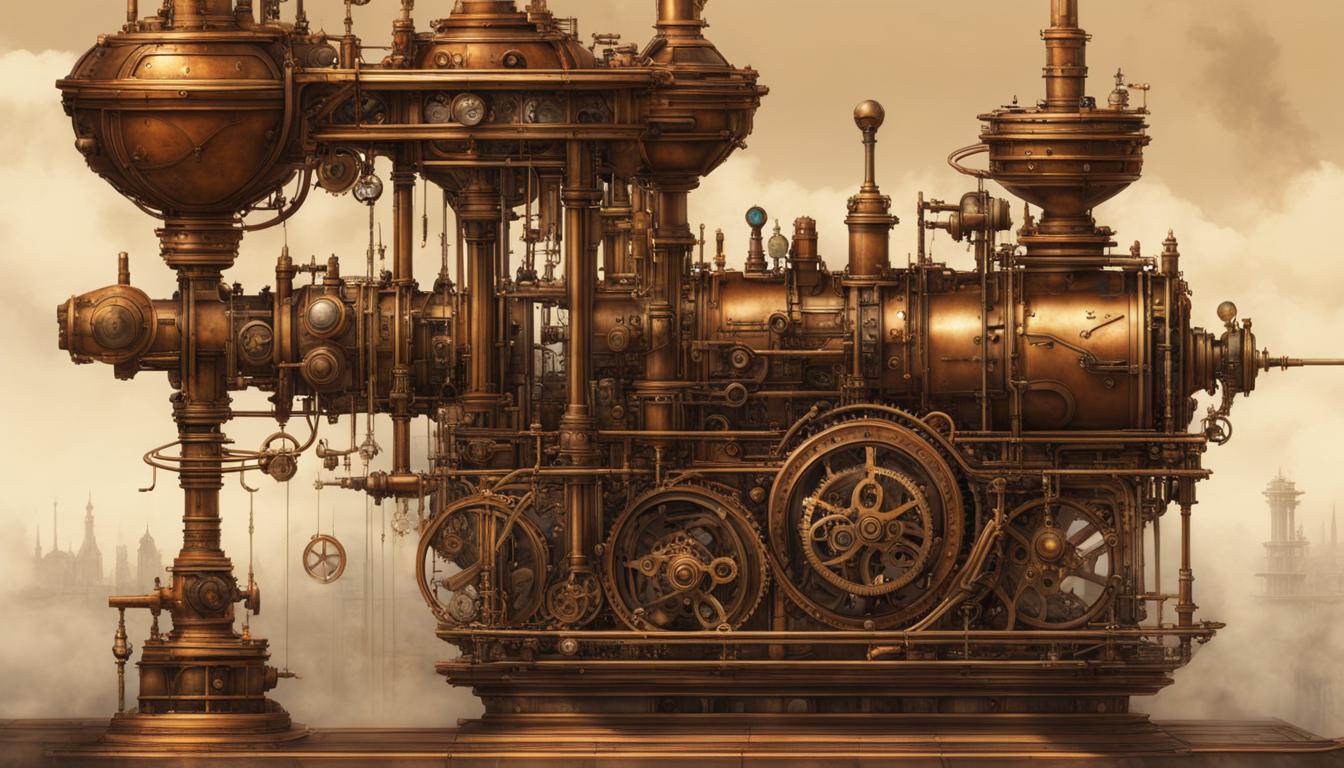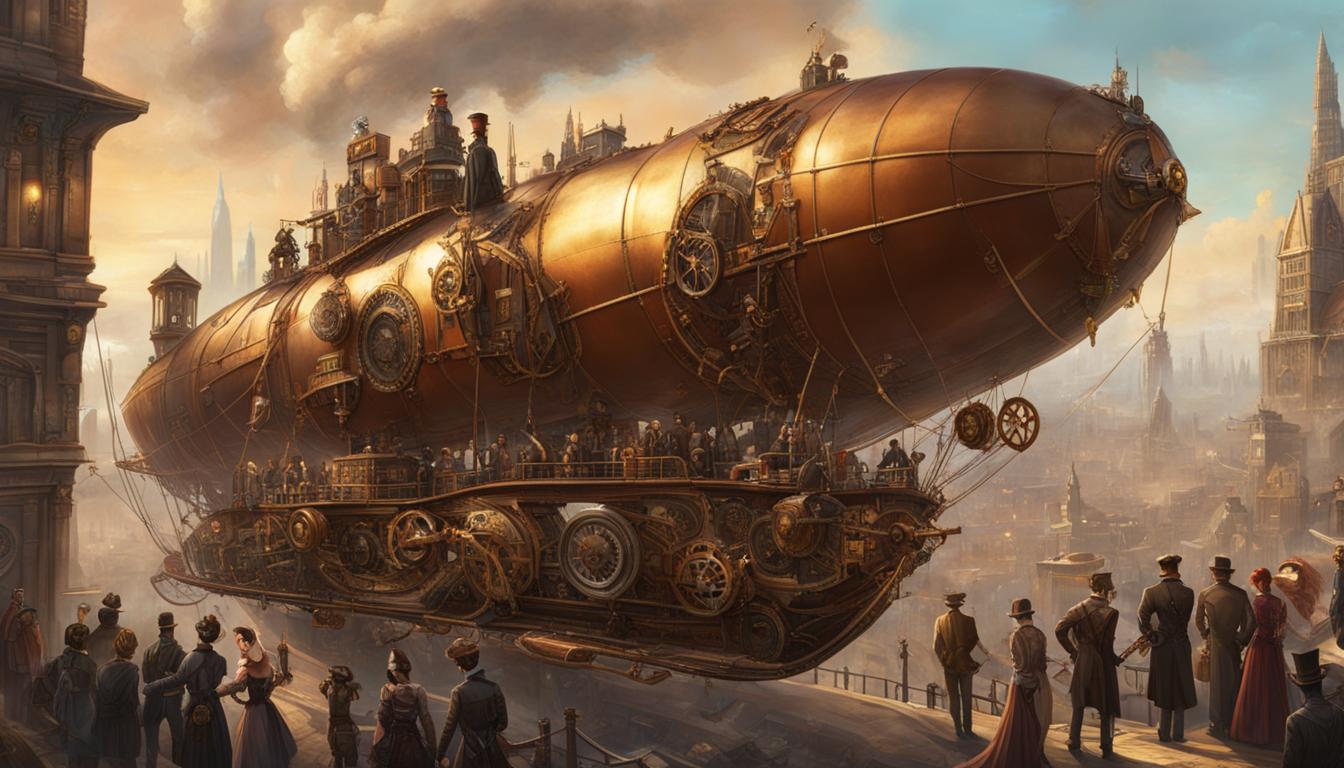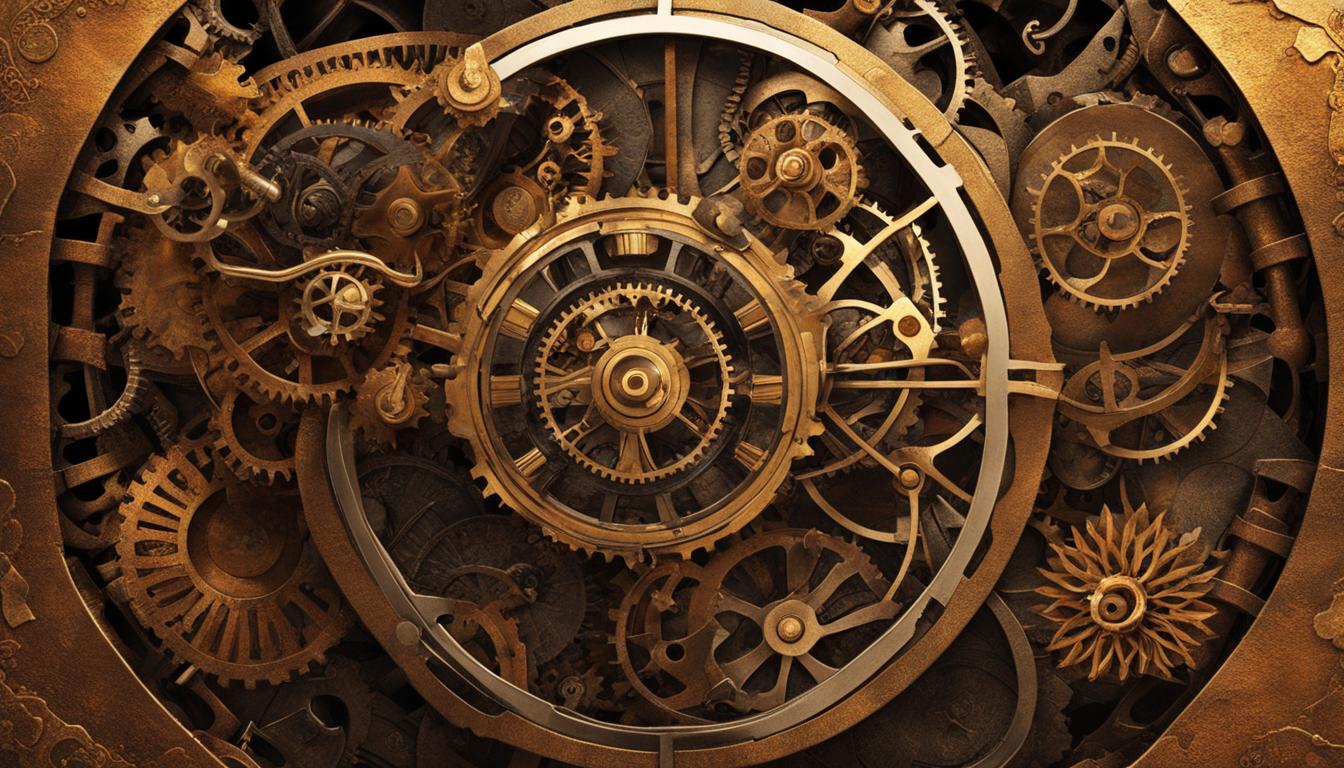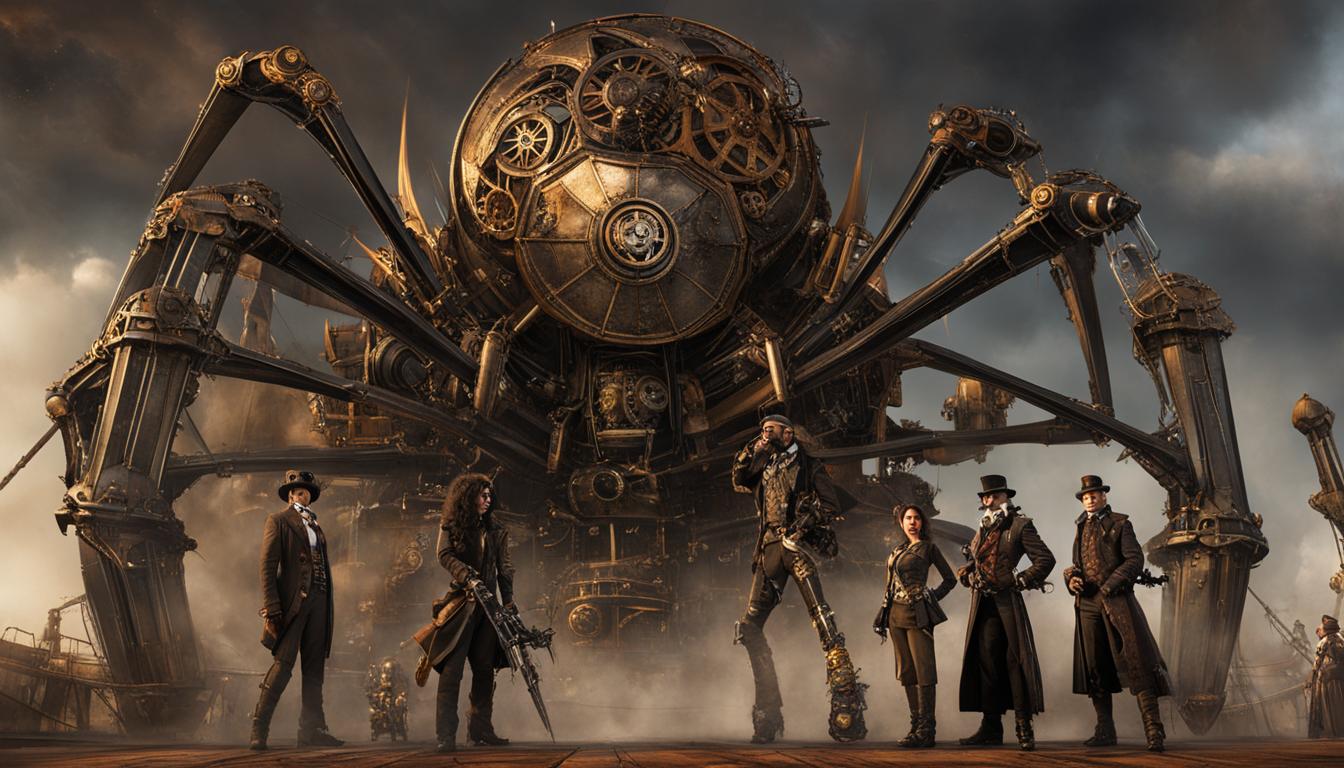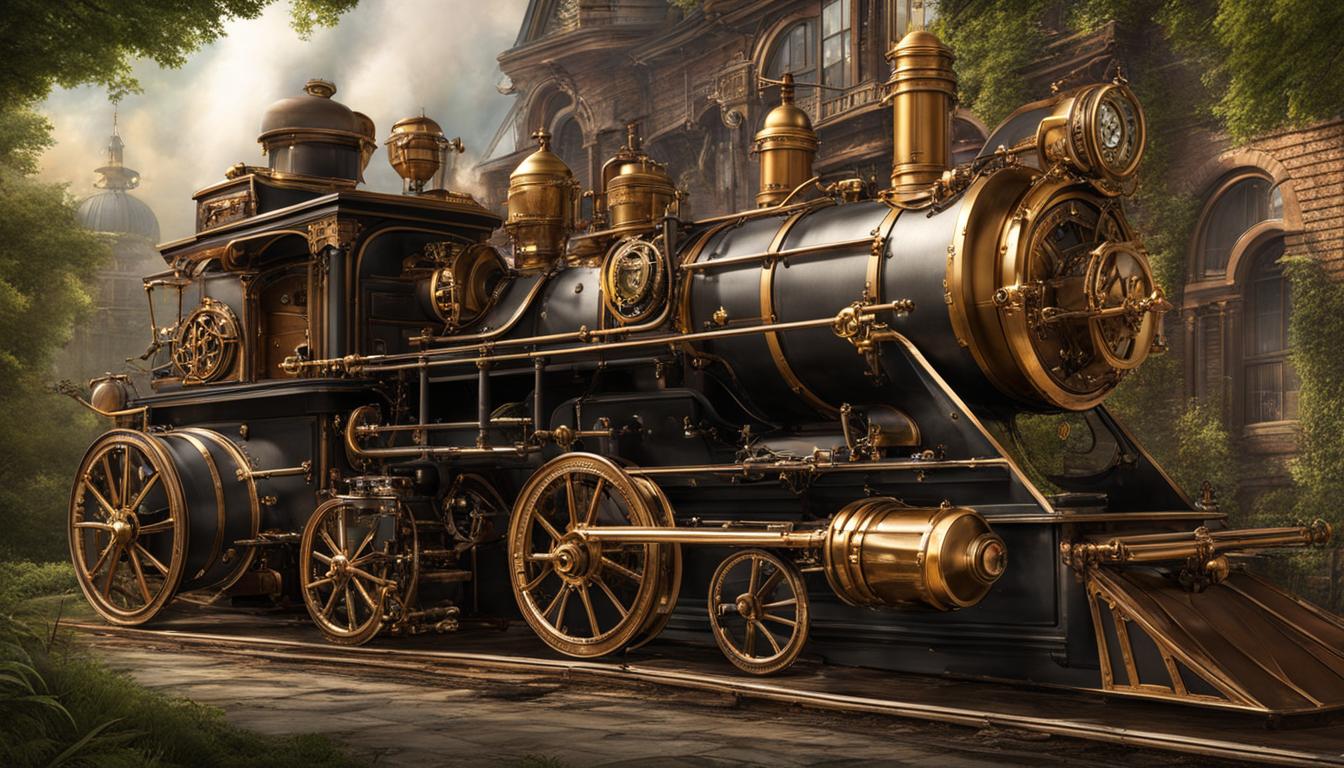Steampunk, a genre that seamlessly blends history and fantasy, has captured the imaginations of readers and creators alike. With its vintage aesthetics and steam-powered machinery, steampunk transports us to a time that never was, combining elements of the past with futuristic creativity. However, beneath its surface lies a deeper exploration of the intersection between history and fantasy.
Some critics argue that steampunk narratives tend to have a nostalgic focus on an imaginary Victorian era, often glorifying British imperialism while disregarding the diverse cultural influences that contributed to its development. By acknowledging this critique, we can delve into the complexities of this genre and fully appreciate the historical fantasies it presents.
Key Takeaways:
- Steampunk is a genre that combines historical settings with elements of fantasy and futuristic creativity.
- Some critics argue that steampunk narratives glorify an imaginary Victorian era and fail to acknowledge diverse cultural influences.
- Steampunk often incorporates real historical events and figures into its fantastical stories, offering alternative histories.
- Authors strike a balance between historical accuracy and imaginative storytelling, creating intricate worlds filled with airships and steam-powered machinery.
- Steampunk challenges traditional narratives and offers unique perspectives on historical events, sparking readers’ curiosity.
Historical Events in Steampunk Fantasy Tales
Steampunk narratives have a unique ability to blend fact and fiction, incorporating real historical events and figures into their fantastical stories. This genre allows authors to explore alternative histories by reimagining how technology and inventions could have shaped the course of historical events. One of the most influential authors in this regard is Jules Verne, whose works like “20,000 Leagues Under the Sea” are considered seminal in the steampunk genre.
The steampunk approach to history is not limited to one particular era or culture. Instead, it draws inspiration from diverse historical periods and incorporates them into its narratives. This blending of reality and imagination creates intricate worlds filled with airships, steam-powered machinery, and adventure. By incorporating real historical events into steampunk tales, authors captivate readers with their creative interpretations and offer unique perspectives on the past.
Steampunk is a genre that allows us to glimpse a different version of history, where technological advancements and Victorian aesthetics reign supreme, intertwining with the familiar events and figures we know. It’s a delightful blend of fact and fiction that sparks the reader’s curiosity and imagination.
One of the key aspects of steampunk’s alternative history is the exploration of what could have happened if certain events had unfolded differently. Steampunk authors reimagine the outcomes of famous battles, speculate on the consequences of technological advancements, and challenge traditional narratives. This imaginative approach breathes new life into historical events, presenting them in a way that captures readers’ attention and invites them to ponder the possibilities of a different past.
| Historical Event | Steampunk Interpretation |
|---|---|
| The Industrial Revolution | A world where steam-powered machinery dominates everyday life, transforming society and transportation. |
| The American Civil War | An alternative timeline where advanced steam-powered weaponry drastically alters the outcome of the war. |
| The Age of Exploration | Explorers equipped with futuristic airships venture into uncharted territories, uncovering hidden civilizations and ancient technologies. |
Historical Figures in Steampunk
Steampunk also features the inclusion of historical figures who become key players in its alternative histories. From inventors and explorers to rulers and rebels, these real individuals are reimagined and given new roles within steampunk narratives. For example, Nikola Tesla, known for his contributions to electrical engineering, is often portrayed as a genius inventor whose creations form the backbone of steampunk technology.
In conclusion, steampunk’s incorporation of historical events and figures brings a sense of familiarity to its fantastical tales. By blending fact and fiction, authors create captivating narratives that invite readers to explore alternative versions of history. Steampunk encourages us to question the limitations of reality and sparks our imagination to envision a world where history took a different turn.
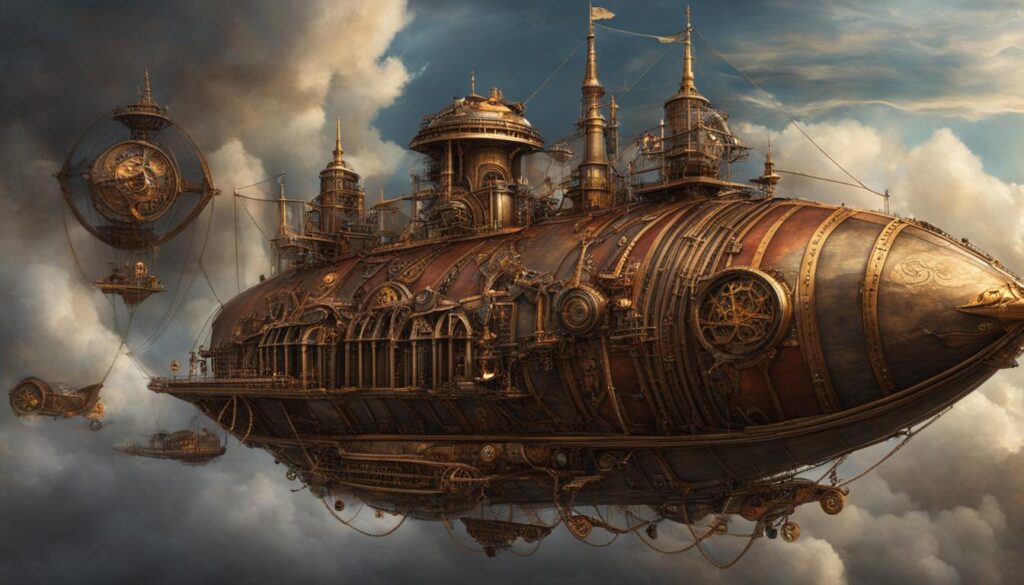
In the world of steampunk, historical accuracy is carefully balanced with the imaginative storytelling that defines the genre. Writers meticulously research the historical elements they incorporate into their narratives, ensuring an authentic foundation. They then infuse these historical details with fantastical twists, introducing steam-powered machinery, airships, and other imaginative elements that transport readers to alternate worlds and realities.
Steampunk’s blend of history and fantasy goes beyond aesthetics. It also provides a platform for reimagining the past, challenging traditional narratives, and encouraging readers to question what could have been. By exploring alternative histories and envisioning how technology could have shaped events differently, steampunk narratives offer fresh perspectives and ignite curiosity.
Table: Historical Accuracy vs. Imagination in Steampunk
| Historical Accuracy | Imagination |
|---|---|
| Authentic historical research | Fantastical elements |
| Real historical events and figures | Alternate histories |
| Recreation of past aesthetics | Imaginative inventions |
In conclusion, steampunk’s seamless merging of history and fantasy creates a genre that is both grounded in reality and boundlessly creative. By embracing historical accuracy while infusing narratives with imaginative elements, steampunk authors transport readers to rich and vibrant worlds that challenge conventional norms. Through this blend of reality and imagination, steampunk continues to captivate audiences and leave an indelible mark on literature and popular culture.
Steampunk’s Imaginative Takes on Historical Events
Steampunk narratives transport readers to alternative versions of history, offering imaginative twists on well-known events. By incorporating elements of fantasy and futuristic technology into historical settings, steampunk authors challenge traditional narratives and spark curiosity about what could have been.
One example of steampunk’s alternative history is the reimagining of famous battles. In these narratives, authors delve into the “what ifs” of warfare, exploring how technological advancements could have altered the outcomes. Imagine the Battle of Waterloo with steam-powered weapons or the American Civil War fought with mechanized soldiers. Steampunk’s imaginative approach allows for captivating storytelling while shedding new light on historical events.
“Steampunk offers a unique perspective on historical events, inviting readers to question the conventional narrative and consider alternative possibilities,” says renowned steampunk author, Emily Armstrong. “By blending reality with imagination, steampunk allows us to explore how the fusion of history and fantasy can reshape our understanding of the past.”
But steampunk’s alternative history isn’t limited to battles alone. Authors also explore the consequences of technological advancements in their narratives. These stories may present an alternate reality where steam-powered machinery and inventions shape the course of history in unexpected ways. From airships crisscrossing the skies to automatons assisting with everyday tasks, steampunk narratives offer readers a glimpse into an imaginative past where the possibilities are endless.
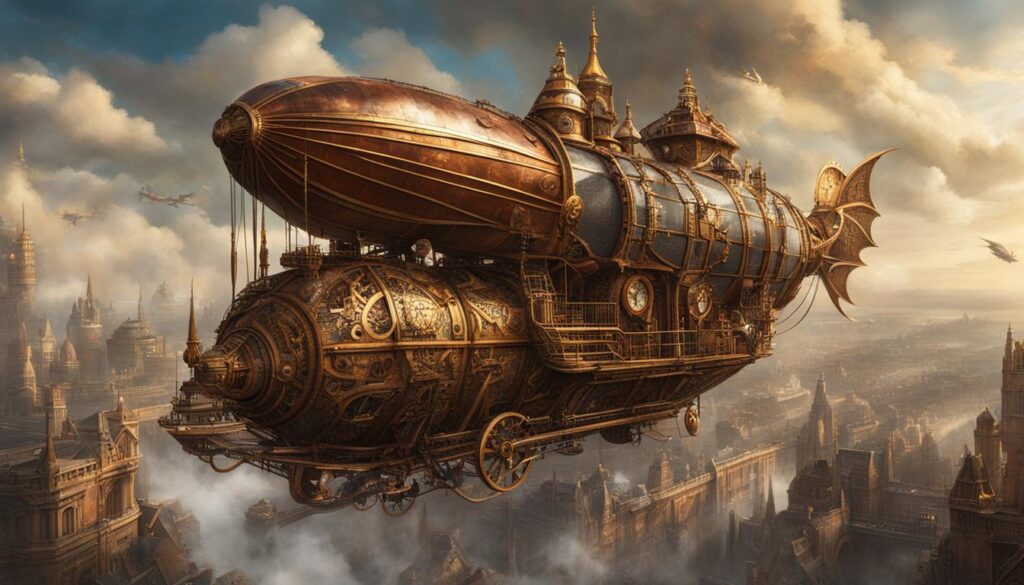
Exploring New Worlds and Ideas
Steampunk’s blend of history and fantasy opens up a world of exploration and creativity. By reimagining historical events through the lens of futuristic technology, authors challenge readers to question established narratives. This genre allows for a deeper understanding of the past while sparking the imagination and inspiring new possibilities for the future.
So, next time you pick up a steampunk novel or dive into a steampunk-inspired video game, remember that you’re stepping into a world where history and fantasy collide, offering a unique perspective on the events that shaped our world.
Conclusion
Steampunk’s impact on literature and popular culture is undeniable. With its unique blend of history and fantasy, it has created a captivating genre that continues to enchant audiences. From its humble literary beginnings, steampunk has expanded its influence to encompass fashion, art, and even video games, becoming a cultural phenomenon.
As the popularity of steampunk grows, so does its potential for the future. This genre has the power to become even more inclusive and diverse, incorporating a wide range of cultural influences. By embracing different perspectives and narratives, steampunk can push the boundaries of creative imagination.
Steampunk’s enduring appeal lies in its vibrant aesthetic and imaginative storytelling. It allows authors and creators to explore alternative histories, challenging traditional narratives and sparking the reader’s curiosity. By reimagining the past and infusing it with fantastical elements, steampunk breathes new life into historical events.
With its rich tapestry of adventure, technology, and imagination, steampunk is sure to continue making an impact on literature and popular culture. Whether in books, movies, or immersive experiences, the allure of steampunk will continue to captivate audiences and transport them to a world where history and fantasy intertwine.
FAQ
What is steampunk?
Steampunk is a genre that combines historical settings with elements of fantasy and futuristic creativity. It often features steam-powered machinery and vintage aesthetics.
What is the criticism surrounding steampunk narratives?
Some critics argue that many steampunk narratives have a nostalgic focus on an imaginary Victorian era, glorifying British imperialism. They fail to acknowledge the diverse cultural origins of the elements they celebrate.
How do steampunk narratives incorporate real historical events and figures?
Steampunk stories often take inspiration from various historical periods and cultures, integrating them into their narratives. They reimagine the past with a fantastical twist, creating intricate worlds filled with airships, steam-powered machinery, and adventure.
How does steampunk offer alternative histories?
Steampunk authors explore what could have happened if certain events had unfolded differently. They reimagine the outcome of famous battles or explore the consequences of technological advancements in history.
How does steampunk blend history and fantasy?
Steampunk strikes a balance between historical accuracy and imaginative storytelling. It blends reality and imagination to create engaging narratives that captivate readers.
How does steampunk continue to evolve?
Steampunk has expanded from its literary origins to encompass fashion, art, and video games. As it grows in popularity, it has the potential to become even more inclusive and diverse, incorporating a wide range of cultural influences.

